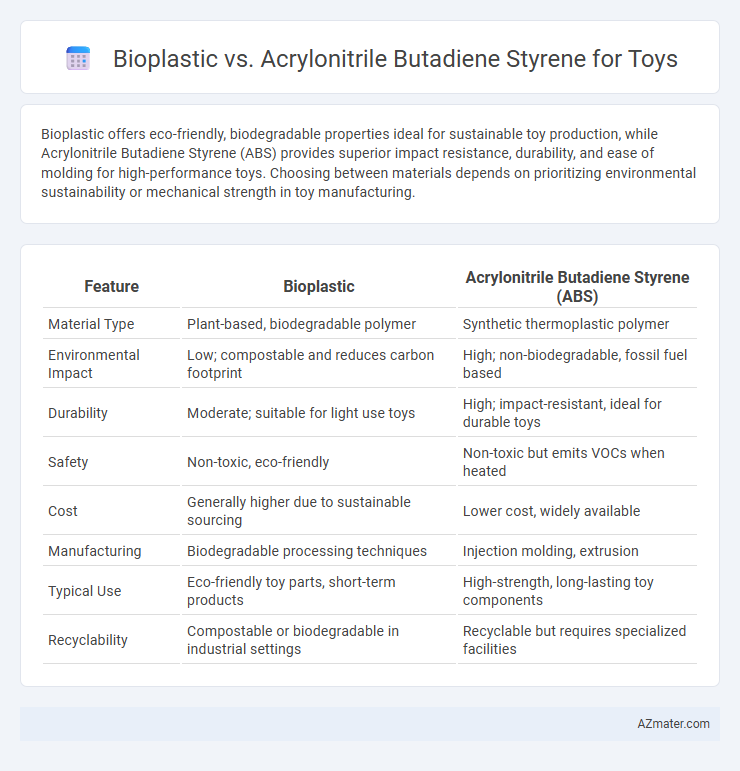Bioplastic offers eco-friendly, biodegradable properties ideal for sustainable toy production, while Acrylonitrile Butadiene Styrene (ABS) provides superior impact resistance, durability, and ease of molding for high-performance toys. Choosing between materials depends on prioritizing environmental sustainability or mechanical strength in toy manufacturing.
Table of Comparison
| Feature | Bioplastic | Acrylonitrile Butadiene Styrene (ABS) |
|---|---|---|
| Material Type | Plant-based, biodegradable polymer | Synthetic thermoplastic polymer |
| Environmental Impact | Low; compostable and reduces carbon footprint | High; non-biodegradable, fossil fuel based |
| Durability | Moderate; suitable for light use toys | High; impact-resistant, ideal for durable toys |
| Safety | Non-toxic, eco-friendly | Non-toxic but emits VOCs when heated |
| Cost | Generally higher due to sustainable sourcing | Lower cost, widely available |
| Manufacturing | Biodegradable processing techniques | Injection molding, extrusion |
| Typical Use | Eco-friendly toy parts, short-term products | High-strength, long-lasting toy components |
| Recyclability | Compostable or biodegradable in industrial settings | Recyclable but requires specialized facilities |
Introduction to Bioplastic and ABS in Toy Manufacturing
Bioplastics, derived from renewable biomass sources like corn starch or sugarcane, offer an eco-friendly alternative to traditional plastics in toy manufacturing by reducing carbon footprint and enhancing biodegradability. Acrylonitrile Butadiene Styrene (ABS) is a petroleum-based thermoplastic renowned for its toughness, impact resistance, and ease of molding, making it a popular choice for durable, high-quality toys. Both materials present unique benefits, with bioplastics catering to sustainability trends and ABS providing robust performance and structural integrity in toy design.
Material Composition and Sources
Bioplastic for toys is primarily derived from renewable plant-based resources such as corn starch, sugarcane, and cellulose, offering a biodegradable alternative to traditional plastics. Acrylonitrile Butadiene Styrene (ABS) is a petroleum-based thermoplastic composed of acrylonitrile, butadiene, and styrene monomers, providing durability and impact resistance. While bioplastics emphasize sustainability through organic sources, ABS relies on fossil fuels and synthetic polymers to achieve robustness and moldability in toy manufacturing.
Environmental Impact: Bioplastic vs ABS
Bioplastic offers a significantly lower environmental impact compared to Acrylonitrile Butadiene Styrene (ABS) in toy manufacturing due to its biodegradability and reduced carbon footprint during production. ABS, derived from fossil fuels, contributes to long-term pollution and landfill accumulation because it is non-biodegradable and challenging to recycle. The use of bioplastics helps reduce greenhouse gas emissions and reliance on non-renewable resources, making it a more sustainable choice for eco-conscious toy producers.
Mechanical Properties: Strength and Durability
Bioplastics exhibit moderate tensile strength and impact resistance, making them suitable for lightweight toys but less durable under heavy stress compared to Acrylonitrile Butadiene Styrene (ABS). ABS offers superior mechanical properties, including high impact strength, toughness, and resistance to wear, which enhance the durability and longevity of toys subjected to frequent handling and rough play. The rigidity and resilience of ABS outperform most bioplastics, ensuring better structural integrity and reduced risk of deformation or breakage over time.
Safety and Non-Toxicity for Children
Bioplastic offers enhanced safety and non-toxicity for children's toys due to its natural, biodegradable composition free from harmful chemicals like BPA and phthalates. Acrylonitrile Butadiene Styrene (ABS), while durable and impact-resistant, may contain residual monomers and additives that pose potential health risks through prolonged exposure or ingestion. Prioritizing bioplastic materials in toy manufacturing reduces toxic exposure, ensuring safer play environments and compliance with stringent child safety standards.
Manufacturing Processes and Scalability
Bioplastic manufacturing involves processes like extrusion, injection molding, and 3D printing using renewable raw materials such as corn starch or sugarcane, offering lower environmental impact but facing challenges in thermal stability and production scalability. Acrylonitrile Butadiene Styrene (ABS) utilizes established injection molding and extrusion techniques with petroleum-based inputs, providing high robustness, heat resistance, and scalability for mass production in toy manufacturing. While ABS remains preferred for high-volume manufacturing due to cost efficiency and mechanical properties, ongoing advancements in bioplastic processing aim to enhance scalability and performance to meet toy industry demands.
Cost Comparison and Market Availability
Bioplastic toys typically have higher material costs due to renewable raw materials and lower economies of scale compared to Acrylonitrile Butadiene Styrene (ABS), which benefits from mass production and widespread availability, making it more cost-effective. ABS dominates the toy market with extensive supply chains and consistent quality, while bioplastics face limited market availability and variability in performance. Manufacturers often prefer ABS for budget-friendly, durable toys, whereas bioplastics appeal in niche markets prioritizing sustainability despite higher costs and limited accessibility.
Design Flexibility and Aesthetics
Bioplastic offers design flexibility through easy molding and color customization, enabling unique shapes and eco-friendly finishes ideal for sustainable toys. Acrylonitrile Butadiene Styrene (ABS) provides superior durability and surface smoothness, supporting vibrant colors and intricate detailing for high-quality, visually appealing toys. Both materials accommodate aesthetic diversity, but ABS excels in achieving sharp, glossy finishes essential for premium toy designs.
Recycling and End-of-Life Considerations
Bioplastic offers enhanced recyclability and biodegradability compared to Acrylonitrile Butadiene Styrene (ABS), which is a petroleum-based thermoplastic with limited recycling options primarily through mechanical processes. Bioplastics, derived from renewable resources like corn starch, can break down more efficiently in industrial composting facilities, reducing landfill accumulation and environmental impact. ABS toys, while durable and strong, pose challenges in end-of-life management due to their resistance to degradation and reliance on energy-intensive recycling methods.
Future Trends in Sustainable Toy Materials
Bioplastic is gaining momentum as a sustainable alternative to Acrylonitrile Butadiene Styrene (ABS) in toy manufacturing due to its biodegradability and reduced carbon footprint. Innovations in PLA, PHA, and starch-based bioplastics enhance durability and safety, addressing traditional concerns of performance and cost associated with ABS. The future trend indicates increasing adoption of bioplastics driven by consumer demand for eco-friendly toys and evolving regulatory frameworks promoting circular economy principles.

Infographic: Bioplastic vs Acrylonitrile Butadiene Styrene for Toy
 azmater.com
azmater.com